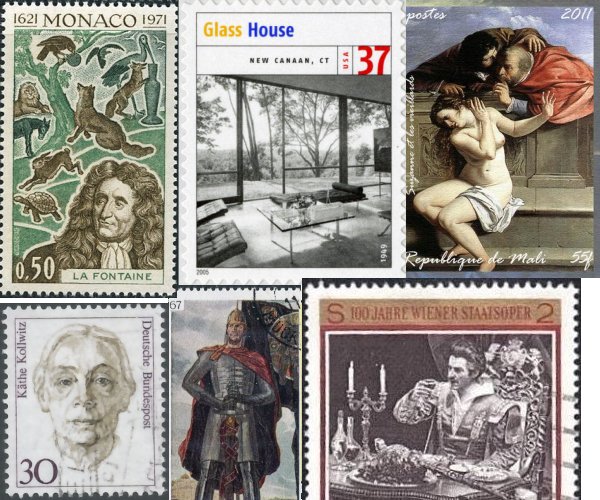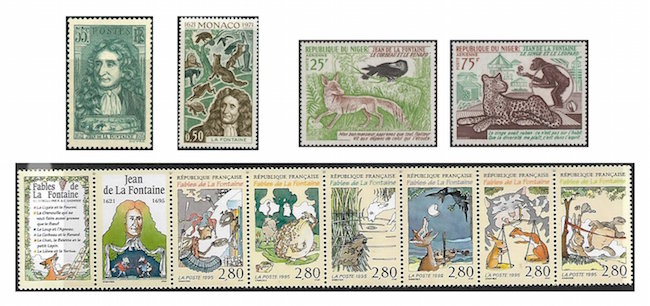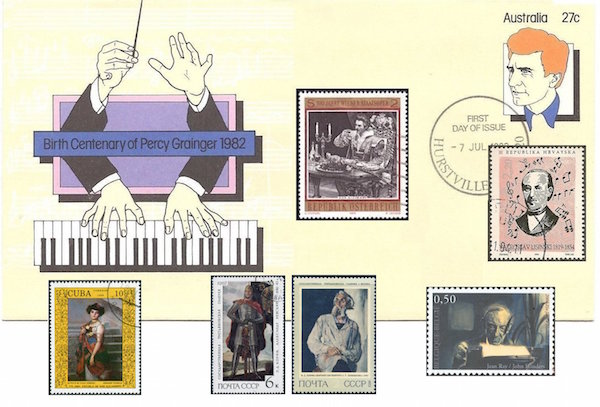The Arts on Stamps of the World — July 8
An Arts Fuse regular feature: the arts on stamps of the world.

By Doug Briscoe
The French fabulist Jean de La Fontaine is our headliner today, along with one of the most prominent American architects, Philip Johnson, and two important woman artists, Artemisia Gentileschi of the seventeenth century and Käthe Kollwitz of the late nineteenth and twentieth. We have other painters, too: the Cuban Armando Menocal and the Russian Pavel Korin. Classical music is represented by Percy Grainger, Austrian baritone Eberhard Wächter, and Croatian composer Vatroslav Lisinski. As for writers, other than La Fontaine we have only one, the Belgian who used the pseudonym Jean Ray.
Jean de La Fontaine (8 July 1621 – 13 April 1695) did not write his immortal fables until he was in his forties. In the decade or so prior to that he had composed only some lightweight poetry and an adaptation of Terence’s Eunuchus (1654). The first volume of Contes (Tales) came out in 1664, a second volume in 1666, and the first six books of the Fables, with stories taken mostly from Aesop and Horace, in 1668. The full set of these was not completed until 1694, with the later pieces being derived from newer sources and more elaborated. The first stamp honoring La Fontaine was issued in 1938. 1972 saw the issuance of a stamp from Monaco and three from Niger (of which I show two, “The Crow and the Fox” and “The Monkey and the Leopard”). In 1995 France released a whole strip of stamps illustrating the famous fables.
One of the most celebrated of the buildings of architect Philip Johnson (July 8, 1906 – January 25, 2005) is his Glass House in New Canaan, Connecticut, built in 1949. The house was “his” not only in its design but as his residence. An interior view of the house was chosen for the Philip Johnson entry in the 2005 sheet of stamps highlighting American architecture. Most of his important work was done for American cities, New York in particular, but Boston was not left out: we have the Johnson Building (1972) at the BPL.

The daughter and eldest child of the Tuscan painter Orazio Gentileschi was also the most gifted of his offspring, Artemisia Gentileschi (July 8, 1593 – c1656). She was only seventeen when she painted the remarkable Susanna and the Elders in 1610. It appears on a 2011 sheet from Mali, as does her most famous work, Judith Slaying Holofernes (1614-20). Gentileschi regularly chose subjects of strong or suffering women in her biblical and mythological pieces. She herself suffered rape at the hands of her father’s colleague Agostino Tassi. When Tassi refused to marry her, her father pressed charges and won the case. She subsequently married another artist, Pierantonio Stiattesi, and moved with him to his hometown of Florence. Her work was greatly admired, she was patronized by the Medici, and she became the first woman ever admitted to the city’s Academy of the Arts of Drawing. But always seeking new commissions, Gentileschi moved from Florence to Rome to Venice and finally to Naples, where she seems to have found a home. She did join her father in London in 1638, remaining at the court of Charles I until 1642. An interval in which her movements are unknown to us is followed to a return to Naples no later than 1649. Her date of death, too, is unknown, with some scholars speculating that she was felled by the plague that struck the city in 1656. Two more of her pieces that show up on stamps (from Liberia and Madagascar) are The Penitent Magdalene of 1630 and Danaë (1612). A movie dramatizing her life, but criticized for its ahistorical treatment, is Artemisia (1997) by Agnès Merlet.
Another excellent woman artist, but one much closer to our time, was Käthe Kollwitz (8 July 1867 – 22 April 1945), She, too, worked in painting, as well as sculpture, but is perhaps better known for her etching, lithography, and woodcuts. A similar accomplishment to Gentileschi’s entry to Florence’s academy was Kollwitz’s admission to the Prussian Academy of Arts in 1920, again the first woman to be thus honored. But to go back to her earlier years, she was born in Königsberg and took lessons in drawing and making plaster casts in childhood. Always keenly interested in social inequity, she made drawings of working people in her teens and was profoundly moved by a performance of Gerhart Hauptmann’s play The Weavers (1892) to create a cycle of lithographs and etchings on the subject (the struggle of weavers against the Industrial Revolution in 1844). Another cycle, on a similar theme, was her work on The Peasants’ War (1902-08). (It was, by the way, this historical event that involved the woodcarver Tilman Riemenschneider, about whom we wrote here just yesterday.) One of these etchings, The Prisoners, appears on a United Nations stamp of 1989. Kollwitz would suffer her own serious losses in the years to come: her son Peter was killed early in World War I, and her grandson, also Peter, fell in action in World War II. She was forced from her position at the Academy of Arts by the Nazis, and her home was destroyed in a bombing that claimed many of her works. She died only two weeks before the war ended. A less troubled example of her work is one of several pieces with the title Mother and Child on a stamp from the DDR. The rest of the stamps are portraits of the artist herself.

For our next collage I use a complete envelope as a backdrop for a few unrelated stamps. Percy Grainger (1882 – 20 February 1961) was remembered in his centennial year with this Australian postal envelope. He moved to the US in 1914 and remained for the rest of his life, taking citizenship in 1918. He composed many original works but is perhaps better known for his arrangements of such favorites as “Country Gardens.”
Austrian baritone Eberhard Wächter (Waechter) (1929 – 29 March 1992) is shown portraying Don Giovanni in another of the 1969 stamps issued for the centenary of the Vienna State Opera, which Wächter headed from 1991 until his death the following year. He took part in a number of famous classic recordings, including the unforgettable 1956 Karajan Rosenkavalier (as Faninal), the groundbreaking 1958 Solti Rheingold (as Donner), and in the title rôle for the great Giulini Don Giovanni of 1959.
Vatroslav Lisinski (1819 – 31 May 1854) is credited with the first Croatian opera, Love and Malice (Ljubav i zloba, 1846), as well as orchestral and choral works and songs. There is a concert hall named for him in Zagreb.

Cuban painter Armando Menocal (July 8, 1863 – September 28, 1942) was born and died in Havana. He studied there and in Spain, where he held an exhibition or two and won several awards. He fought in the Cuban War of Independence and became an art teacher at the school he had attended in his youth, later being named its director. We see his Portrait of Elena Herrera. There are at least two other Cuban stamps that show his work, but I wasn’t able to find satisfactory online images of them.
Russian painter Pavel Korin (8 July [O.S. 25 June] 1892 – 22 November 1967) began his artistic career painting and restoring icons. In Moscow he worked as an assistant to the artist Mikhail Nesterov on frescoes for the Intercession Church, and the older man, impressed with Korin’s work, insisted that he receive formal training and got him admitted to the Moscow School of Painting, Sculpture and Architecture in 1912. After the Revolution many religious works of the type Korin had specialized in were endangered by ideology, and Korin was moved to express in art the passing of a way of life. He planned a massive work to which he gave the working title Requiem for Russia, but his supporter Maxim Gorky suggested a subtler title, Farewell to Rus. (In 1926, Korin and his brother secretly saved a number of pieces from the Convent of Martha and Mary that were marked for destruction.) Korin found acceptance from the Soviet regime and was permitted to travel with Gorky to Italy in the 1930s. In the 1940s, he was called upon to paint portraits of distinguished academics, including the sculptor Sergey Konenkov (1947), as seen on one of the two USSR stamps. (Konenkov’s birthday is two days away.) The other presents his Alexander Nevsky of 1942. Korin also created mosaics for the Moscow Metro system. All this while he was still making sketches and preliminary studies for his grand Farewell to Rus, but in fact he never so much as started work on the canvas. Lest you remain tantalized beyond endurance, here is an image of one of Korin’s studies for the project.
The Belgian writer of detective and horror stories and fantastic tales Raymundus Joannes de Kremer (8 July 1887 – 17 September 1964) used the pen names John Flanders and, more famously, Jean Ray. He began in journalism and went on to write great numbers of stories, about a hundred of them involving his American detective Harry Dickson. He also wrote for young readers, including comic strip scenarios. Available in English are Ghouls in my Grave (1965) and The Horrifying Presence and Other Tales (2009). His novel Malpertuis (1943) was made into a 1971 movie with Orson Welles.
A graduate of the University of Massachusetts with a B.A. in English, Doug Briscoe worked in Boston classical music radio, at WCRB, WGBH, and WBUR, for about 25 years, beginning in 1977. He has the curious distinction of having succeeded Robert J. Lurtsema twice, first as host of WGBH’s weekday morning classical music program in 1993, then as host of the weekend program when Robert J.’s health failed in 2000. Doug also wrote liner notes for several of the late Gunther Schuller’s GM Recordings releases as well as program notes for the Boston Classical Orchestra. For the past few years he’s been posting a Facebook “blog” of classical music on stamps of the world, which has now been expanded to encompass all the arts for The Arts Fuse.
